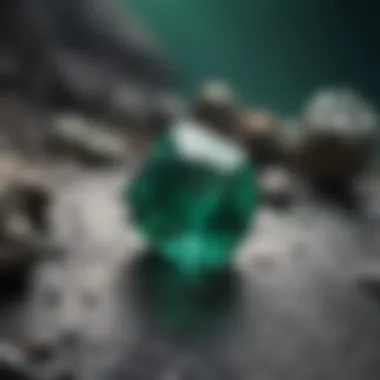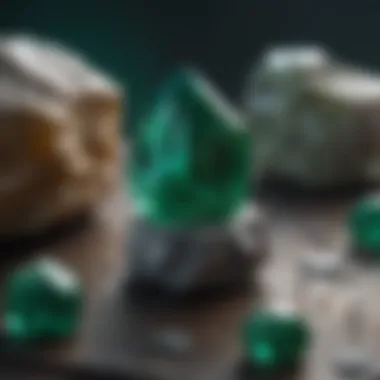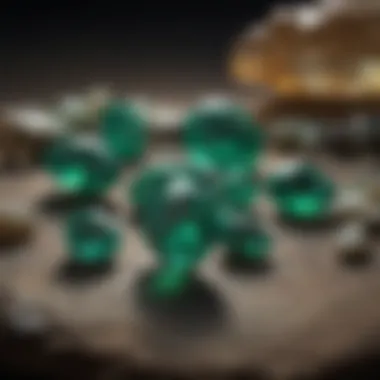Emeralds and the Mohs Scale: A Comprehensive Guide


Featured Collectible of the Month
Overview
Emerald is a gemstone that captivates both collectors and gem enthusiasts. This gem, known for its vivid green hue, is not just visually appealing; it also holds a significant place in the geological and gemological arenas. The emerald, a variety of the mineral beryl, is classified according to its hardness on the Mohs scale. This classification helps both collectors and jewelers understand its durability and the care it requires. Emeralds typically have a Mohs hardness of 7.5 to 8, marking them as relatively durable but not indestructible. The collection of emeralds offers a glimpse into Earth's geological history and represents a connection to various cultural narratives.
Historical Significance
Emeralds have long been prized throughout human history. They were considered sacred by the ancient Egyptians and were even buried with pharaohs. In various cultures, emeralds symbolize rebirth and love. Their green color has fascinated civilizations for centuries, leading to their use in royal regalia and their mention in ancient texts. The significance of emeralds extends beyond mere aesthetics; they embody myths, trade routes, and the interplay of cultures.
Identification Techniques
Visual Characteristics
Identifying emeralds requires an attentive eye. The unique green color, combined with their natural inclusions called "jardin," can help distinguish them from other green gems. Unlike many gemstones, emeralds often contain these minute internal flaws, which are considered a part of their charm rather than imperfections. A skilled collector can detect whether an emerald is natural or synthetic by examining these inclusions.
Resources for Identification
For collectors seeking to identify emeralds, several resources can be beneficial:
- Gemological Institute of America (GIA): A leading authority on gemology, providing comprehensive information on emeralds and other gemstones.
- The International Gem Society: Offers educational articles and forums where collectors can share their experiences and knowledge.
- Books: Titles such as "Emeralds: A Gem of the Ages" provide both historical context and identification tips.
Emeralds are not just collectibles; they are pieces of history woven into the fabric of human culture.
Care and Preservation
Given their level of hardness, emeralds do require special care. It is advisable to avoid exposure to extreme temperatures and harsh chemicals that could harm the stone. Regular cleaning with a soft cloth and mild soap can help maintain their luster. Knowledge of proper care can significantly affect the longevity of the gemstone in a collection.
Ending
Understanding emeralds in the context of the Mohs scale enriches both the appreciation and knowledge of gem collectors. Beyond their beauty, emeralds serve as important markers in the history of minerals and gemstones, representing trade, culture, and nature's artistry.
Understanding the Mohs Scale
The Mohs scale is an essential tool to comprehend mineral hardness, which directly affects the classification of gemstones like emeralds. Understanding this scale enhances the knowledge of collectors since it allows them to assess the durability and potential uses of different minerals. For emeralds, their position on this scale not only indicates their resilience but also informs care practices, guiding collectors to maintain their beauty over time.
Definition of the Mohs Scale
The Mohs hardness scale, created by Friedrich Mohs in 1812, categorizes minerals based on their scratch resistance. It ranges from 1 to 10, with talc assigned a value of 1 (the softest) and diamond rated as 10 (the hardest). Each mineral on the scale can scratch those below it and can be scratched by those above. This relative measurement helps users choose suitable materials for applications based on durability requirements.
History and Development of the Scale
The development of the Mohs scale reflected a need for a simple yet effective means to communicate mineral hardness. Friedrich Mohs, a geologist, aimed to devise a straightforward method for evaluating minerals. Over time, this system evolved and became widely adopted in geology and gemology. Mohs' idea has influenced how collectors, jewelers, and scientists classify and evaluate minerals, shaping the field significantly.
How the Scale Works
The scale operates on a simple principle of scratch resistance. Each mineral is tested against others to determine its position. In the case of emeralds, they rank around 7.5 to 8 on the Mohs scale. This positioning signals a high degree of hardness, meaning emeralds can resist scratching from many common materials. However, it's crucial to note that while emeralds exhibit substantial toughness, they still require proper care to avoid damage from harsher substances.


Understanding the Mohs scale is vital not just for evaluating hardness but for making informed decisions about care, usage, and collection of gems.
Emeralds in Geological Context
The geological context of emeralds is crucial for understanding not only their formation but also the factors that dictate their quality and rarity. This section delves into the intricate processes that lead to the birth of an emerald and highlights specific geographical locales where these gemstones can be found. By exploring the geology behind emeralds, collectors gain insight into what makes different stones unique and valuable.
Formation of Emeralds
Emeralds form primarily from the mineral beryl, with the chemical formula Be₃Al₂(SiO₃)₆. Their lush green color comes from traces of chromium and vanadium. The formation process typically occurs in metamorphic rocks under high-pressure and high-temperature conditions. Imagine a scenario where minerals like beryl come together in a unique combination, often influenced by surrounding environmental conditions.
Emerald formation takes place in pegmatites or metamorphic rocks rich in aluminum. The process can take millions of years. As the conditions are just right, the beryl crystal structure can incorporate chromium ions. The presence of these ions directly influences the color and quality of the resulting emeralds. Furthermore, the crystals grow within mineral-rich veins that sometimes contribute inclusions. These inclusions can affect the clarity of the emerald.
Emeralds can rarely form in other types of rocks, but the most notable and valued varieties are from metamorphosed limestone or sedimentary deposits. The geographic and geological specifics, such as temperature and pressure, lead to different appearances in each crystal. These variances are why knowledge of formation is critical for any collector.
Locations of Major Emerald Deposits
Emeralds are found in several key regions around the world, each offering its own distinct characteristics and qualities. Understanding these deposits gives collectors insight into where to search and what to expect.
Some major emerald deposits include:
- Colombia: Often regarded as the premier source of high-quality emeralds, Colombian emeralds are revered for their rich color and historical significance. The Muzo and Chivor mines are particularly noteworthy.
- Zambia: Zambian emeralds are recognized for their deep green hues and good clarity. These stones often exhibit a more vivid color thanks to the unique geological conditions in the region.
- Brazil: Brazil produces a variety of emeralds with colors ranging from pale green to deep green hues. The state of Minas Gerais is particularly famous for its emerald mines.
- Afghanistan: Lesser-known but still significant, Afghan emeralds are mined in the Panjshir Valley and tend to have distinct characteristics influenced by their environment.
"Emeralds are not just gemstones; they represent a convergence of geological forces and rare environmental conditions that create beauty over eons."
These locations contribute to the richness of emeralds available to collectors. Each deposit has its own unique qualities that can dictate the value and rarity of the stones found therein. Collectors would do well to familiarize themselves with these geological contexts when assessing potential purchases or collecting opportunities.
Physical Properties of Emeralds
Understanding the physical properties of emeralds is crucial in the context of this article. Emeralds, though prized for their aesthetic beauty, have specific material characteristics that significantly influence their value and usability. The examination of these properties provides insights for collectors and enthusiasts, guiding their decisions during acquisition and preservation.
Chemical Composition
Emeralds are a variety of the mineral beryl, and their chemical formula can be expressed as Be3Al2(SiO3)6. This indicates that emeralds are composed mainly of beryllium, aluminum, and silicon. What sets emeralds apart from other beryl variants is the presence of trace amounts of chromium and vanadium. These elements are instrumental in giving emeralds their distinctive green color.
Understanding the chemical composition is essential. It informs collectors about the potential durability and behavior of the stone under various conditions. For instance, higher chromium content often correlates with a richer green hue, which is desirable in the gemstone market. A well-informed collector knows that variations in this chemical makeup can affect both valuation and care considerations.
Color and Clarity
The color of emeralds is one of the key factors that contribute to their allure. While green is the most recognized hue, the saturation and tone can vary significantly. Ideal emeralds exhibit a vivid green color, which is often enhanced by transparency. Clarity grades also play a fundamental role in defining emerald quality.
Emeralds often contain inclusions, which are natural imperfections. These are typically accepted in the context of emeralds more than in other gemstones. Still, clarity assessments impact pricing and desirability. For collectors, this understanding is vital; it helps them distinguish between gemstones that are simply beautiful and those that are of high quality.
Crystal Structure
Emeralds possess a hexagonal crystal structure, which is a defining feature of their formation. This structure contributes not only to the appearance of the gemstone but also to its physical properties, such as its hardness on the Mohs scale, which typically ranges from 7.5 to 8. This means emeralds are relatively durable, though they are more prone to chipping than harder gemstones like diamonds.
Knowing the crystal structure of emeralds aids collectors in understanding how to handle and display them. Proper care can prevent damage, preserving both the physical integrity and the market value of these gems.
"Emeralds are not just beautiful; their physical and chemical properties tell a story of nature's artistry and complexity."


Emerald Hardness on the Mohs Scale
Understanding the hardness of emeralds plays a critical role in their evaluation, appreciation, and care. The Mohs scale of mineral hardness is a qualitative scale, ranging from 1 to 10, indicating a mineral's ability to resist scratching by other substances. Emeralds, classified at 7.5 to 8 on this scale, exhibit significant durability while also offering unique beauty. This section will explore the specifics of emerald hardness, its implications for collectors, and the relevance of this knowledge in daily use.
Emerald Hardness Rating
Emeralds are rated between 7.5 and 8 on the Mohs scale. This rating means they are relatively hard, making them resistant to everyday wear and tear. For context, it is essential to understand how emeralds compare to other gemstones and minerals. While lower-ranked substances may scratch easily, emeralds hold up well under typical conditions. However, they are not entirely impervious to damage.
It is also important to note that factors like internal inclusions can affect the overall durability of an emerald. The most prized emeralds have clarity, but many contain characteristics typical of their formation process. Designers and collectors alike should care for these gems by considering their hardness. Using protective measures, such as safe storage and careful cleaning, ensures that emeralds retain their brilliance for many years.
Comparison with Other Gemstones
When compared with other gemstones, emeralds demonstrate various levels of hardness:
- Diamond: Rated 10, this mineral is the hardest known, resistant to scratching.
- Ruby and Sapphire: Both rated 9, they are also highly durable and commonly used in fine jewelry.
- Topaz: Rated 8, is comparable to emerald but may differ in terms of susceptibility to damage.
- Amethyst: At 7, it is softer and requires more careful handling than emeralds.
Emeralds, exuding beauty and elegance, provide a balance between hardness and flair. They stand firm in settings where more delicate stones may falter, though they still warrant respectful treatment. The knowledge of hardness allows collectors to appreciate their emeralds properly while understanding limitations in daily wear.
"Emeralds demand respect due to their unique characteristics and relative hardness; a knowledgeable collector understands both their strengths and vulnerabilities."
Implications for Collectors
Understanding the implications surrounding emeralds is vital for collectors who wish to safeguard their investments and enhance their collections. Collectors must not only be aware of the beauty of emeralds but also of their physical and environmental implications. The aspects of care and preservation greatly affect the longevity of the stones. Proper handling and storage can prevent damage and maintain their value over time.
Care and Preservation Techniques
Emeralds require specific care techniques due to their natural inclusions and delicate crystal structures.
- Cleaning: It’s crucial to clean emeralds gently. A simple solution of warm water and mild soap can be effective. Use a soft brush to remove dirt without scratching the surface. Avoid ultrasonic cleaners and steam cleaners as they may damage the stone.
- Storage: Store emeralds in a soft cloth or separate boxes to prevent scratching. Do not place them near harder gemstones. The softer emerald should be given dedicated space to avoid contact with other jewels.
- Handling: Always handle emeralds with clean hands. Oils and dirt can accumulate on the surface, leading to dullness. It’s best to wear them only when necessary, to avoid exposure to chemicals in cosmetics and perfumes.
"Emeralds are not just beautiful; they are also delicate. Proper care is essential for maintaining their allure."
Identifying Quality Emeralds
Quality emeralds are determined not only by their color and size but also by their clarity and cut. Understanding how to identify high-quality emeralds is important for collectors seeking value.
- Color: The most desirable emeralds exhibit a rich, vibrant green. Colors that lean too much toward blue or yellow may be considered of lower quality.
- Clarity: All emeralds have inclusions, but fewer inclusions mean a higher quality stone. Look for emeralds with fewer visible internal flaws.
- Cut: The cut is vital in showcasing the beauty of the emerald. A well-proportioned cut enhances the overall appearance and sparkle of the stone.
- Carat Weight: Larger emeralds are rarer and more valuable, but size should be considered along with other quality factors.
When purchasing emeralds, obtaining a certificate from a reputable gemological laboratory can confirm the stone's quality and grade. Remember, informed decisions lead to better collecting outcomes.
Cultural Significance of Emeralds
Emeralds hold a prominent position in various cultures around the world. Their deep green hue and historical value elevate them beyond mere gemstones. This section examines the significance of emeralds throughout history and in modern society, illustrating their multifaceted roles.
Emeralds in History
Emeralds have been cherished since ancient times. In ancient Egypt, they were valued for their beauty and attributed to the goddess Isis. The Pharaohs adorned themselves with emeralds, believing they offered protection and enhanced fertility. It is reported that Cleopatra famously possessed a large collection of emerald jewelry.


Furthermore, the Roman Empire utilized emeralds extensively. Jewelers crafted them into intricate designs, signifying wealth and power. Emeralds were so esteemed that they were often used as gifts among royalty and high-ranking officials.
In addition, the Spanish Conquistadors discovered vast emerald mines in South America during their conquest. The exploitation of these resources fueled trade and economic growth, leading to the emergence of emeralds as one of the most sought-after gemstones in the West. Their historical context adds depth to their significance, framing emeralds as symbols of luxury and status throughout various civilizations.
Emeralds in Modern Culture
Today, emeralds continue to captivate people around the globe. They are often featured prominently in luxury items such as high-end jewelry. Many celebrities have been spotted wearing stunning emerald necklaces and rings, propelling their popularity in contemporary fashion.
Emeralds also symbolize growth and renewal in modern culture. Many view them as stones of wisdom and harmony, often associating them with balance and tranquility. They appear in wellness practices, believed to provide benefits for emotional healing and stress relief.
Beyond aesthetics, emeralds serve as reminders of our connection to the earth. The rise of ethical sourcing has sparked conversations about the origins of gemstones and the environmental impact of mining. Consumers increasingly seek responsibly mined emeralds, reflecting a cultural shift towards sustainable practices and consciousness.
"Emeralds are not just beautiful; they represent history, power, and a commitment to ethical luxury in our modern world."
In summary, the cultural significance of emeralds transcends their physical properties. They narrate stories of past civilizations and reflect the evolving values of contemporary society. Their storied history and evolving place in modern culture ensure that they remain relevant and cherished artifacts in our world.
Emeralds in the Gem Community
Emeralds hold a distinguished place in the gem community, captivating collectors and enthusiasts alike. Their unique beauty and inherent rarity make them a focal point of fascination and investment. The significance of emeralds goes beyond aesthetics; they are narrative pieces that reflect not just geological formations but also cultural histories and market dynamics. Understanding emeralds’ roles in the gem community allows collectors to make informed decisions and appreciate these stones on multiple levels.
Emeralds in Gem Shows
Gem shows serve as pivotal platforms for showcasing emeralds to a broader audience. These events allow collectors and dealers to exhibit their collections, share knowledge, and establish connections. At shows like the Tucson Gem and Mineral Show or the JOGS Gem and Jewelry Show, emeralds take center stage.
The following points summarize their importance at these shows:
- Networking Opportunities: Collectors, buyers, and sellers can meet, facilitating discussions on trends, pricing, and quality assessments.
- Education: Expert-led seminars on emerald grading, treatment, and market behavior lend insight into the complexities of collecting.
- Marketplace Diversity: Shows feature a wide variety of emeralds, from raw stones to finely crafted jewelry, appealing to both purists and casual buyers.
- Current Trends: Attendees gain firsthand knowledge of emerging trends in emerald popularity, design styles, and market values.
Emeralds in Jewelry Trends
Emeralds influence and reflect current jewelry trends, signifying opulence and elegance. This stone often appears in contemporary designs, solidifying its status as a timeless choice. Recent trends indicate a rise in unique cuts and innovative settings. Here are noteworthy aspects of how emeralds shape jewelry trends:
- Vintage and Art Deco Revival: Antique and vintage designs featuring emeralds are making a comeback, captivating new generations.
- Sustainable Sourcing: Ethical considerations drive demand for responsibly sourced emeralds, prompting jewelers to highlight their sustainable practices.
- Customization: Personalized jewelry pieces featuring emeralds enable collectors to express their individual style.
- Mixed Materials: Jewelers are increasingly incorporating emeralds with alternative materials, like wood or ceramic, creating unique contrasts that appeal to modern tastes.
The role of emeralds in the gem community is not merely ornamental; it is foundational to understanding market dynamics and cultural reverence.
As the gem community continues to evolve, emeralds will undoubtedly remain a significant touchstone in both investment and personal expression.
Future Perspectives on Emeralds
Emeralds hold significant value not only for their beauty but also for their unique characteristics within the field of gemology. Looking ahead, several important aspects will shape the future of emeralds, particularly in technologies and environmental considerations. Understanding these elements ensures that collectors are well-informed about the challenges and advancements affecting the emerald market.
Emerging Technologies in Gemology
Emerging technologies are transforming the field of gemology. Innovations such as 3D imaging, artificial intelligence, and enhanced optical techniques allow for better identification and grading of emeralds. For collectors, this means access to more precise information regarding provenance and authenticity. For example, advanced imaging can reveal internal structures that indicate natural formation versus synthetic replication, helping to protect against potential fraud.
Additionally, technologies like blockchain are being adopted to track the supply chain of gemstones. This transparency could lead to increased consumer trust and higher demand as buyers seek ethically sourced emeralds. It is crucial for collectors to stay updated on these technologies to make informed decisions.
Environmental Considerations in Emerald Mining
The environmental impact of emerald mining is under increasing scrutiny. Mining activities can disrupt ecosystems and lead to habitat destruction. Consequently, there is a growing push for sustainable practices in this industry. Collectors should be aware of the origins of their emeralds and the methods used in their extraction. Supporting mines that prioritize sustainable and ethical methods can contribute to preserving the environment while ensuring the longevity of emerald availability.
Emerging regulations and certifications, such as the Responsible Jewellery Council standards, aim to promote ethical practices in emerald mining. As consumers become more conscious of environmental issues, this trend may drive future demand for responsibly sourced emeralds. Collectors may find that adopting a focus on sustainability not only benefits the planet but could also enhance the overall value of their collections.
The future of emeralds is intertwined with advancements in technology and a growing emphasis on sustainable practices. This evolution will shape the landscape for collectors and consumers alike.



